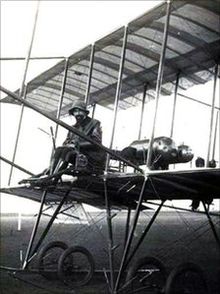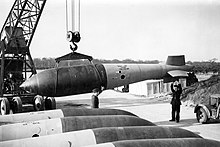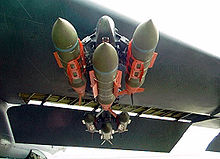Aerial bomb

An aerial bomb is a type of explosive or incendiary weapon intended to travel through the air on a predictable trajectory, usually designed to be dropped from an aircraft. Aerial bombs include a vast range and complexity of designs, from unguided gravity bombs to guided bombs, hand tossed from a vehicle, to needing a large specially built delivery vehicle; or perhaps be the vehicle itself such as a glide bomb, instant detonation or delay-action bomb. The act is termed aerial bombing. As with other types of explosive weapons, aerial bombs are designed to kill and injure people and destroy materiel through the projection of blast and fragmentation outwards from the point of detonation.
Early bombs[]



The first bombs delivered to their targets by air were single bombs carried on unmanned hot air balloons, launched by the Austrians against Venice in 1849 during the First Italian War of Independence.[1]
The first bombs dropped from a heavier-than-air aircraft were grenades or grenade-like devices. Historically, the first use was by Giulio Gavotti on 1 November 1911, during the Italo-Turkish War.[2]


In 1912, during the First Balkan War, Bulgarian Air Force pilot Christo Toprakchiev suggested the use of aircraft to drop "bombs" (called grenades in the Bulgarian army at this time) on Turkish positions.[citation needed] Captain Simeon Petrov developed the idea and created several prototypes by adapting different types of grenades and increasing their payload.[3]
On 16 October 1912, observer Prodan Tarakchiev dropped two of those bombs on the Turkish railway station of Karağaç (near the besieged Edirne) from an Albatros F.2 aircraft piloted by Radul Milkov, for the first time in this campaign.[3][4][5][6]
Technical description[]
Aerial bombs typically use a contact fuze to detonate the bomb upon impact, or a delayed-action fuze initiated by impact.
Reliability[]
Not all bombs dropped detonate; failures are common. It was estimated that during the Second World War about 10% of German bombs failed to detonate, and that Allied bombs had a failure rate of 15% or 20%, especially if they hit soft soil and used a pistol-type detonating mechanism rather than fuzes.[7] A great many bombs were dropped during the war; thousands of unexploded bombs which may be able to detonate are discovered every year, particularly in Germany, and have to be defused or detonated in a controlled explosion, in some cases requiring evacuation of thousands of people beforehand. Old bombs occasionally detonate when disturbed, or when a faulty time fuze eventually functions, showing that precautions are still essential when dealing with them.
See also[]
- Aerial bombing of cities
- Area bombardment
- Bomber
- Explosive weapons
- Strategic bombing
- Tactical bombing
Types of aerial bomb:
- Cluster bomb
- Concrete bomb
- Earthquake bomb
- Incendiary bomb
- General-purpose bomb
- Gravity (dumb) bomb
- Guided (smart) bomb
References[]
- ^ Millbrooke, Anne (2006). Aviation History. Jeppesen. pp. 1–20. ISBN 0-88487-235-1.
- ^ Grant, R.G. (2004). Flight - 100 Years of Aviation. Dorling-Kindersley Limited. p. 59. ISBN 9780751337327.
- ^ Jump up to: a b Who was the first to use an aircraft as a bomber? (in Bulgarian; photographs of 1912 Bulgarian air-dropped bombs)
- ^ A Brief History of Air Force Scientific and Technical Intelligence Archived December 30, 2008, at the Wayback Machine
- ^ "The Balkan Wars: Scenes from the Front Lines". TIME. 8 October 2012. Retrieved 28 July 2015.
- ^ I.Borislavov, R.Kirilov: The Bulgarian Aircraft, Vol.I: From Bleriot to Messerschmitt. Litera Prima, Sofia, 1996 (in Bulgarian)
- ^ Brian Melican (23 April 2018). "'They haven't lost their potency': Allied bombs still threaten Hamburg". The Guardian. Retrieved 23 April 2018.
External links[]
| Wikimedia Commons has media related to Air-dropped bombs. |
Britannica: Bomb (entry) https://www.britannica.com/technology/bomb-weapon#ref103516
- Aerial bombs
- Aerial bombing
- Explosive weapons
